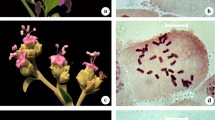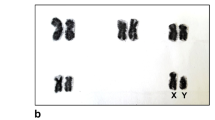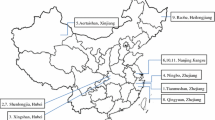Abstract
In this paper the Authors decribe the karyogram of three species of Scincidae (Chalcides chalcides chalcides, Chalcides ocellatus tiligugu, and Mabuya striata). The diploid number of these species is 2n=28. It is not possible to subdivide the chromosome set in micro- and macrochromosomes or to recognize the heterochromosomes morphologically. Ch. ocellatus and M. striata have very similar karyograms; that of Ch. ch. chalcides is different in that chromosomes 6, 7, 8, 9, and 10 are acrocentric. Pericentric inversion is probably involved in the karyotypic evolution of these species.
Similar content being viewed by others
References
Beçak, W.: Chromosomes numbers and sex chromosomes in Serpentes. Mammalian Chromosomes 8, 4–10 (1967).
—, M. L. Beçak, and H. R. S. Nazareth: Karyotypic studies of two species of South American snakes (Boa constrictor amarali and Bothrops jararaca). Cytogenetics 1, 305–313 (1962).
Cole, J., C. H. Lowe, and J. W. Wright: Sex chromosomes in Lizard. Science 155, 1028–1029 (1967).
Dallai, R., and C. Baroni Urbani: Fine resolution of the karyogram of Lacerta sicula campestris (De Betta). Caryologia (Firenze) 20, 347–353 (1967).
Goin, C. Y., and O. B. Goin: Introduction to herpetology. Amphibian and reptilian chromosomes 1-341. San Francisco and London: W. H. Freman & Co. 1962.
Gorman, G. C., and L. Atkins: Chromosomal heteromorphism in some male lizard of the genus Anolis. Amer. Nat. 100, 579–583 (1966).
—, and T. Holzinger: New karyotypic data on 15 genera of lizard in the family Iguanidae, with a discussion of taxonomic and cytological implication. Cytogenetics 6, 286–299 (1967).
Kobel, H. R.: Heterochromosomen bei Vipern berus L. (Viperidae, Serpentes). Experentia (Basel) 18, 173–174 (1962).
—: Vergleich der chromosomen-satze von Vipera berus L. und Vipern aspis L. (Viperidae, Serpentes). Arch. Klaus-Stift. Vererb.-Forsch. 38, 67–75 (1963).
Makino, S.: An atlas of the chromosome number in animals, 2nd ed. Ames: Iowa State College Press (1951).
Matthey, R.: Nouvelle contribution à l'étude des chromosomes chez les sauriens. Rev. suisse Zool. 40, 281–315 (1933).
—: L'évolution de la formule chromosominale chez les vertébrés. Experientia (Basel) 1, 78–86 (1945).
—: Cytologie comparée et taxonomie des Chamaleontidae (Reptilia-Lacertilia). Rev. suisse Zool. 64, 709–732 (1957).
Nakamura, K.: Studies on reptilian chromosomes. II. On the chromosomes of Eumeces latiscutatus (Hallowell), a lizard. Cytologia (Tokyo) 2, 285–401 (1931).
White, M. J. D.: Animal cytology and evolution, 2nd ed. Cambridge: University Press 1954.
Author information
Authors and Affiliations
Rights and permissions
About this article
Cite this article
Dallai, R., Talluri, M.V. A karyological study of three species of Scincidae (Reptilia). Chromosoma 27, 86–94 (1969). https://doi.org/10.1007/BF00326112
Received:
Accepted:
Issue Date:
DOI: https://doi.org/10.1007/BF00326112




